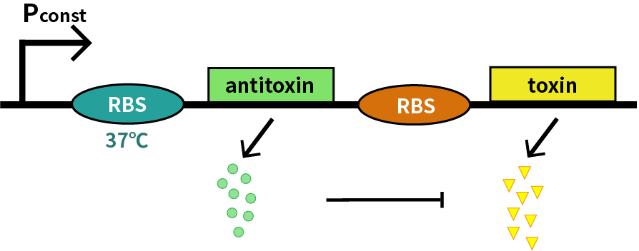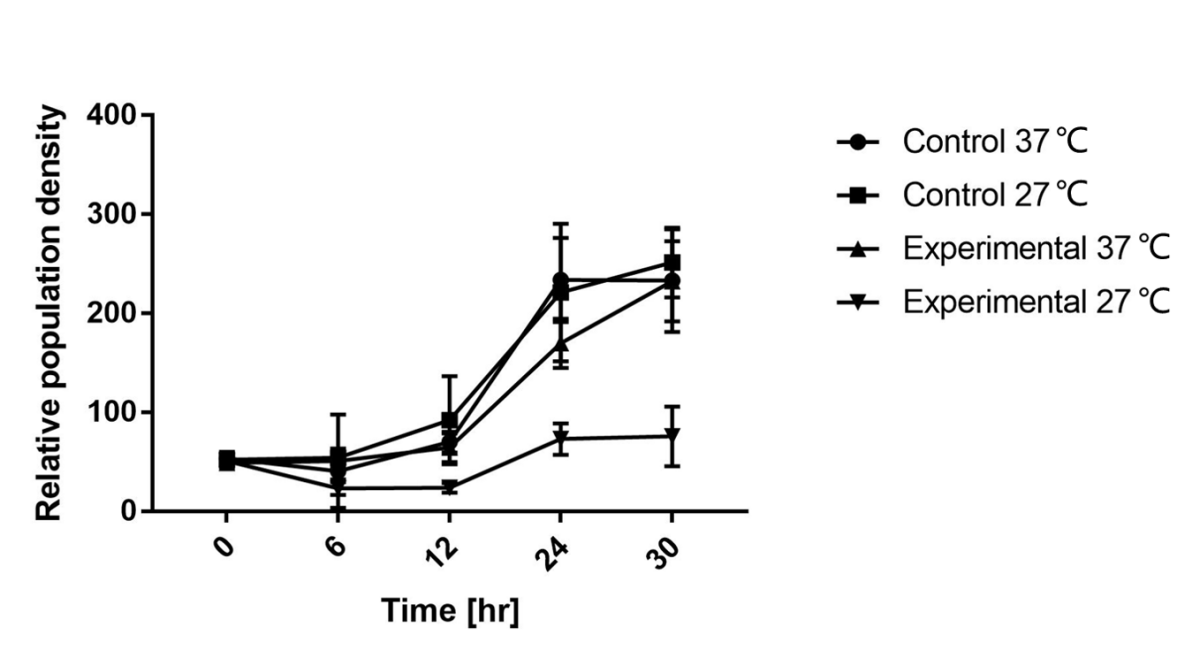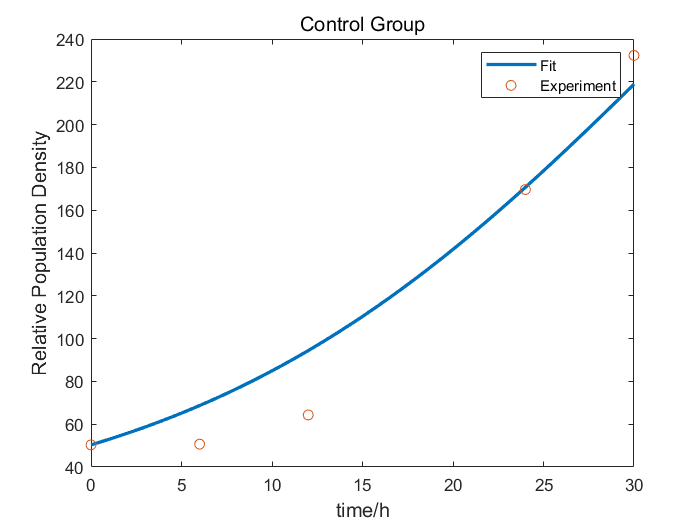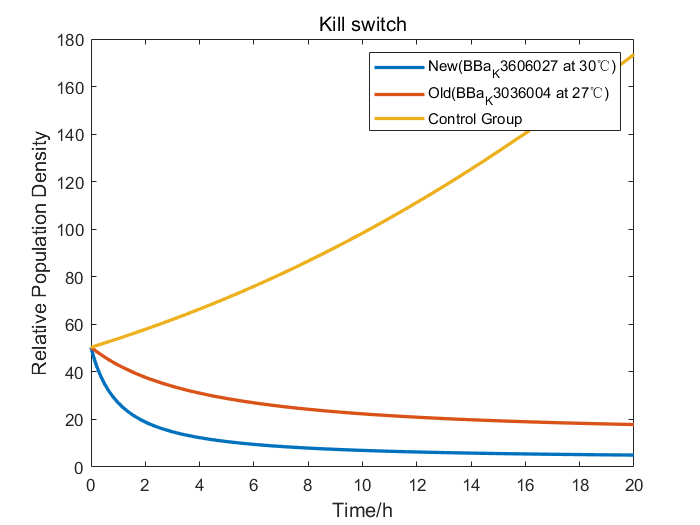Part:BBa_K3036004
Cold triggered kill switch
Kill switch consists of RNA thermometer (BBa_K115002), relE (BBa_K185000), and relB (BBa_K185048), aiming to prevent environmental contamination from the engineered bacteria through a cold-triggered toxin system. The toxin RelE shuts down protein synthesis and causes the death of microbe by cleaving mRNA within the ribosomal A site [1]. The antitoxin RelB counteracts RelE and thereby the inhibits cleavage of mRNA by RelE [2]. In addition, the RNA thermometer mediates expression at a temperature near 37℃ (body temperature), but not at 27℃ (room temperature).Only when the temperature reaches human body temperature can RelB be expressed. When the engineered bacteria get out of human body, temperature drops, inhibiting expression of the antitoxin RelB, and the bacteria die of the excessive toxin RelE, preventing contamination.
| Cold-triggered kill switch | |
| Function | Cold-triggered kill switch |
| Use in | Prokaryotes |
| RFC standard | RFC10 compatible |
| Backbone | pSB1C3 |
| Derived from | Escherichia. coli DH5alpha |
Sequence and Features
- 10COMPATIBLE WITH RFC[10]
- 12COMPATIBLE WITH RFC[12]
- 21INCOMPATIBLE WITH RFC[21]Illegal XhoI site found at 161
- 23COMPATIBLE WITH RFC[23]
- 25COMPATIBLE WITH RFC[25]
- 1000COMPATIBLE WITH RFC[1000]
Design and Properties
Cold-triggered kill switch is characterized in a system where the downstream relE (BBa_K185000) gene encodes for a constantly expressed stable toxin and the upstream relB (BBa_K185048) gene encodes for a labile antitoxin under the control of the RNA thermometer (BBa_K115002). In order to measure the function of this kill switch at 27℃ and 37℃, we take E. coli introduced with a vector with the same backbone as control group.
As is shown in Fig.1, there is nearly no difference of the relative population density between control and experimental groups at 37℃, which indicates the kill switch is not triggered. However, the population density of experimental group shows a significant decrease compared to control group at 27℃, caused by lack of antitoxin, which indicates the kill switch is activated at 27℃.
Experimental approach
1.Transform the plasmids into E. coli DH5α competent cells.
2.A strain containing a vector with same backbone is used as control. Experimental groups and control groups are both cultured in 60mL LB-ampicillin (50 ng/µl) medium overnight at 37℃, 200rpm.
3.Equally divide each group into two flasks, which is 30mL respectively. One of each group is cultured at 27℃, 200rpm and the other at 37℃, 200rpm.
4.Extract 5μl samples of each culture system every 6 hours. Diluted all of the samples to 10^7 times and then spread them on solid LB-ampicillin (50 ng/µl) medium separately.
5.Count the number of colonies in 5 cm^2 per plate after cultured for 24 hours at 37℃.
6.Three repicas are tested in each group.
Model (Added by 2020 Fudan)
We collaborate with BNU-China and adopt their raw wet lab experimental data of RelE/RelB system to construct our model. After studying the data from BNU-China, we found out that without Kill Switch, the colony number curve of control group was fairly similar to the logistic equation. So, we fitted the experimental data to obtain the parameters of the logistic equation. When the Kill Switch exists, the toxin sharply increased the competitive pressure, introducing a parameter of additional pressure α into the equation. Therefore, we fitted the data of cold shock (27℃) group to figure out the value of α.
Furthermore, we performed an efficiency analysis by the adjusted model we had constructed. Our design of BBa_K3606027 employed a more efficient RNA thermometer than that of BNU-China, so we changed the properties to simulate the growth curve of our Kill Switch. The result demonstrated that bacteria carrying our Kill Switch were killed more thoroughly in a smaller temperature range, therefore proved that with our Kill Switch, engineered bacteria would have less deleterious effects on the environment.
Attention (Added by 2020 Fudan)
Potential pathogenicity of RelE
Although, RelE/RelB module poses minimized adverse effects on hosts as it expanding in microbial communities [3], it has several other effects on human intestine. Firstly, RelE is a very rare toxin that has the activity against both prokaryotic and eukaryotic organisms in a similar mechanism. It has been observed that RelE can induce apoptosis in cultured human cell lines. Secondly, RelE/RelB module tends to have unexpected enrichment in bacteria that is not observed for other toxin/antitoxin modules such as MazE/MazF and ParD/ParE. Such enrichment may be associated with the formation of persistence of microbes in the gut. Thirdly, the divisions of bacteria carrying homologues of the RelE toxin involved in comprising the human gut microbiota.
All this effect only been testified in artificial mammalian gene expression systems, so whether it has tangible impact on the human gut microbiome need further study. iGEM teams that focus on intestinal probiotics and have special safety requirements ought to pay special attention to these.
Chromosomally encoded RelE/RelB in gut microbiota
What’s more, RelE/RelB and other toxin/antitoxin modules have homology searches on bacterial chromosomes. RelB-RelE complex can inhibit the promotor of chromosomally encoded RelE/RelB[4].
Homonymic “Relb”
When searching for bacterial RelB toxin, we accidentally found another homonymic “Relb” that sometimes also documented as “RelB” but in vertebrate. Relb is a transcription factor of nuclear factror-kappa B (NF-κB) family and plays a crucial role in inducing inflammation, autoimmune diseases, multiple sclerosis, etc. iGEM teams who want to utilize RelB for Toxin/antitoxin system should distinguish it for the other. Relb for vertebrate seems to haven’t been used by iGEM team before[5].
This new information learned from literature that need attention was added by 2020 Fudan team.Reference
- ↑ Overgaard M , Borch J , Gerdes K . RelB and RelE of Escherichia coli Form a Tight Complex That Represses Transcription via the Ribbon–Helix–Helix Motif in RelB[J]. Journal of Molecular Biology, 2009, 394(2):0-196.
- ↑ Andreas Bøggild, Sofos N, Andersen K R, et al. The Crystal Structure of the Intact E. coli ReIBE Toxin-Antitoxin Complex Provides the Structural Basis for Conditional Cooperativity[J]. Structure, 2012, 20(10):1641-1648.
- ↑ Jones, Brian V. “The human gut mobile metagenome: a metazoan perspective.” Gut microbes vol. 1,6 (2010): 415-31. doi:10.4161/gmic.1.6.14087
- ↑ Unterholzner, Simon J et al. “Toxin-antitoxin systems: Biology, identification, and application.” Mobile genetic elements vol. 3,5 (2013): e26219. doi:10.4161/mge.26219
- ↑ Yang, Meng-Ge et al. “Biological characteristics of transcription factor RelB in different immune cell types: implications for the treatment of multiple sclerosis.” Molecular brain vol. 12,1 115. 27 Dec. 2019, doi:10.1186/s13041-019-0532-6
| None |




